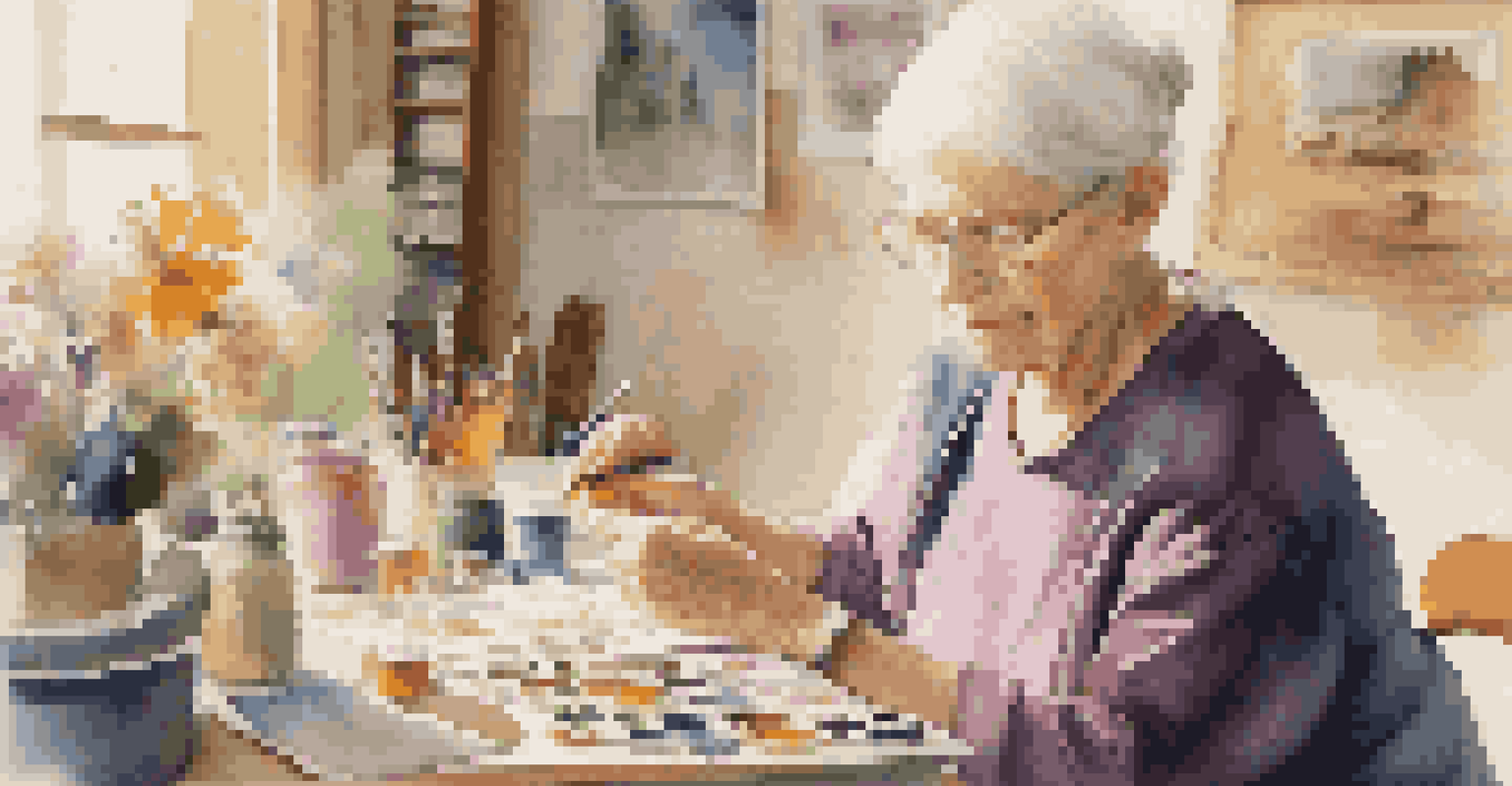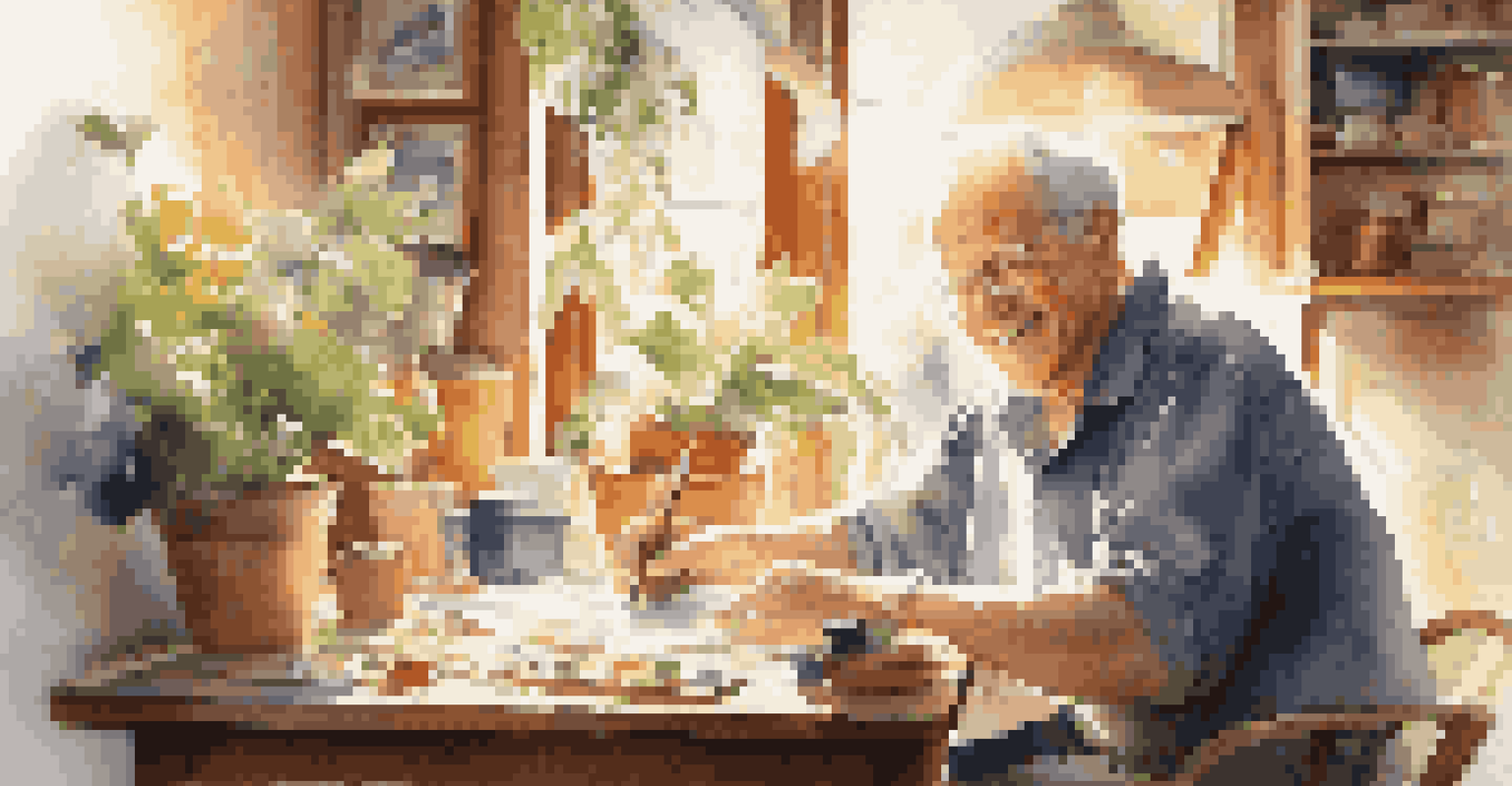The Impact of Art on Physical Health in Older Adults

Understanding the Role of Art in Senior Health
Art encompasses a wide range of expressions, from painting to music, and its impact on health has been a subject of interest for researchers. For older adults, engaging in artistic activities can foster a sense of purpose and connection. This engagement not only enriches their lives but can also lead to improved physical health outcomes.
Art enables us to find ourselves and lose ourselves at the same time.
When seniors participate in art, they often experience reduced feelings of isolation and depression. This social interaction is vital for their overall well-being. Additionally, creative activities can stimulate cognitive function, which is essential for maintaining mental health as we age.
By incorporating art into their daily routine, older adults may find themselves more motivated to move and engage in physical activities. This can lead to better mobility and strength, showcasing the profound influence that art can have on their physical health.
Art as a Medium for Stress Reduction
Stress is a common challenge faced by many older adults, and art can serve as a powerful tool for alleviating it. Engaging in creative activities allows seniors to express their emotions and thoughts in a safe environment. This expression can lead to a significant reduction in anxiety levels, promoting relaxation.

Studies have shown that creating art can lower cortisol levels, the hormone associated with stress. For instance, painting or crafting can provide a meditative experience, allowing the mind to unwind. Furthermore, this process of creating can shift their focus away from daily worries and towards something enjoyable.
Art Boosts Senior Health
Engaging in artistic activities enhances physical, mental, and emotional well-being in older adults.
Incorporating art into stress management routines can enhance an older adult's quality of life. As they discover joy in creating, they may also notice a natural boost in their immune system, contributing to overall better health.
Physical Benefits of Engaging in Art Activities
Participating in art activities can lead to several physical benefits for older adults. For instance, drawing or painting often requires fine motor skills, which can help improve hand-eye coordination. This is crucial for maintaining dexterity and independence in daily tasks.
Creativity takes courage.
Additionally, art projects often involve movement, whether it’s reaching for supplies, standing to paint on a canvas, or even dancing to music. These physical actions contribute to better circulation and muscle strength, promoting overall physical health.
Moreover, the enjoyment derived from these activities can encourage seniors to remain active, further enhancing their physical well-being. Thus, the simple act of creating art can have ripple effects on their physical health.
Art Programs and Their Availability for Seniors
Many communities now offer art programs specifically designed for older adults. These programs provide a supportive environment where seniors can explore their creativity while also socializing with peers. Access to such resources can significantly enhance their overall health and well-being.
Local community centers, senior centers, and even online platforms have begun to embrace the importance of art in healthy aging. By offering classes in painting, pottery, and music, they cater to a variety of interests and skill levels. This inclusivity ensures that every older adult can find an avenue for artistic expression.
Art Reduces Stress
Creative pursuits allow seniors to express themselves and significantly lower anxiety levels.
Participation in these programs not only fosters creativity but also builds a sense of community among seniors. This social aspect can be just as beneficial to their health as the art itself, reinforcing the idea that engagement is key to a fulfilling life.
The Link Between Art and Improved Cognitive Function
Engaging in artistic activities can have a positive impact on cognitive function in older adults. Creative pursuits stimulate the brain, encouraging the formation of new neural connections. This cognitive engagement is crucial for maintaining memory and critical thinking skills as we age.
For example, learning to play an instrument or taking up painting requires concentration and problem-solving abilities. These tasks challenge the brain in ways that can delay cognitive decline and even reduce the risk of dementia. Thus, art serves as a mental workout that keeps the mind sharp.
Research consistently shows that older adults who engage in art-related activities score higher on cognitive tests than their less active peers. This highlights the importance of incorporating creativity into their daily lives to support both mental and physical health.
Art Therapy: A Structured Approach to Healing
Art therapy is a structured therapeutic approach that uses art as a means of communication and healing. It offers seniors the opportunity to express thoughts and feelings they may find difficult to articulate verbally. This form of therapy can be particularly beneficial for those dealing with trauma, grief, or chronic illness.
Trained art therapists guide participants through various creative processes, ensuring that the focus remains on expression rather than artistic skill. This removes the pressure to create something 'perfect,' allowing for genuine exploration and self-discovery. As a result, many seniors find a sense of relief and empowerment through their creative expressions.
Art Programs Foster Community
Community art programs provide vital social connections that enhance the overall health of seniors.
Moreover, art therapy has been shown to improve emotional well-being, which can, in turn, enhance physical health. By addressing emotional issues, seniors can experience a more holistic approach to their overall health.
Incorporating Art into Daily Routines for Seniors
Incorporating art into the daily routines of older adults can be a simple yet effective way to enhance their well-being. This could be as easy as setting aside time for painting, coloring, or even crafting. By making creativity a regular part of their lives, seniors can enjoy ongoing physical and mental health benefits.
To get started, seniors might consider joining a local art class, participating in community workshops, or even trying out online tutorials. The key is to find activities that resonate with their interests and abilities, ensuring that the experience remains enjoyable and fulfilling.

Ultimately, the goal is to create an environment where art becomes a joyful and accessible part of their lives. This not only nurtures creativity but also promotes a healthy and active lifestyle.